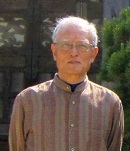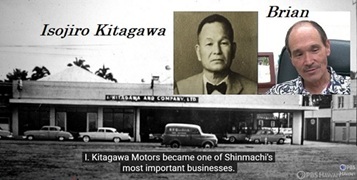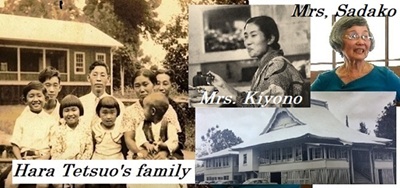


During my research into Nishimura Shikazo, a native of Okikamuro, I recently came across a YouTube video titled "Shinmachi/Stronger Than a Tsunami."
Mr. Isojiro Kitagawa, a native of Okikamuro, who was kind to Shikazo, and Mr. Tetsuo Hara of Hiro Meishoin Temple and his wife, Kiyono, appeared in the youtube. My wife's relative (Michael Fujimoto, Chairman of HPM) also appeared.
"Shinmachi: Stronger Than a Tsunami" focuses on the Japanese business district in Hilo called Shinmachi that was destroyed by a deadly tsunami on April 1, 1946. Families salvaged what they could to rebuild only to have the district wiped out again by another deadly tsunami in 1960. Surviving residents recall the community resilience to keep the spirit of Shinmachi alive today.
1 Hilo's Japanese community was once home to public baths, theaters such as Yamatoza and Ariakekan (Mamo Theater), and a place where Japanese immigrants lived after their farm labor contracts ended. After a major fire in 1914, Shinmachi and Yashijima were developed as new homes. Two tsunamis, in 1946 and 1960, destroyed both towns, and today, the areas have been transformed to the point where no trace of their former selves can be found, with parks and green spaces now available.

2 The rebuilding of Shinmachi and Yashijima by the people was a testament to the immeasurable efforts, hard work, and unity of their ancestors, and the strength of the businesses that were born in these areas, which continue to lead industries in Hilo today, was a documentary that really impressed me.
3 Mr. Isojiro Kitagawa
He is known in many documents as one of the most successful Japanese people on the Big Island, and Brian Kitagawa, the fourth-generation president, shares his memories of the company.
1) He immediately quit working on the sugarcane plantation and made a living as a fish peddler in Shinmachi, where he was extremely skilled at filleting fish and had a talent for selling them.
2) Furthermore, he had a great business acumen, grasping the needs of fishermen and other customers in Shinmachi and Yashijima and acting accordingly. Starting with fishing equipment and general merchandise, Kitagawa Shokai expanded to include fishing boats, gasoline, and automobiles.
3) At the time, banks refused to lend to Japanese people, so Shinmachi and Yashijima fishermen and young entrepreneurs (such as the Hilo Shinmachi Association) needed capital. My great-grandfather started by founding a fishing company, and provided financing and support to various businesses, including the Hilo Rice Mill, American Trading, and Hawaii Planing Mill (HPM).

* According to Kamuro News, people from Okikamuro established the "Hilo Hachiman Ko" in 1901, before the founding of the fishery company. With 42 members and a large amount of savings, the group has earned the highest level of trust in the area, and this shows the strength of their bonds as well as the substantial financial support they receive. (KAMURO No.3 May 1915)
* The Hawaii Hochi reports that Mr. Kitagawa had a colorful life, serving not only as president of Kitagawa Shokai but also as president of SUISAN, chair of the academic affairs committee at Yashijima Japanese Language School, president of Nichibei Sake Brewery, and chairman of the Hilo Japanese Chamber of Commerce.
4 Mr. Tetsuo Hara and his wife Kiyono
Tetsuo Hara, the second founder of Hilo Meishoin Temple, was a native of Okiura Village, Suo-Oshima (a disciple of the grandfather of Hakuseiji Temple's head priest, Shizuo Niyama). Despite his many accomplishments, including promoting coeducation and extensive renovations of the temple buildings, he passed away the year before the outbreak of war between Japan and the United States. (He was 50 years old, and his funeral was a rare splendor. According to Nippu Jiji, eulogies were delivered by Shikazo Nishimura of the Okikamuro Association.)
The third founder, Hino, and his family were forced to return to the US mainland after the outbreak of war. It was Hara's wife, Kiyono, who was tasked with protecting Meishoin Temple during this difficult time. As a teacher at Meisho Girls' Junior High School, she was one of the few people who knew the correct scriptures regarding funerals, and as such, she bore a heavy burden. (The school was closed and the facilities were used for military purposes.) Kiyono's daughter, Sadako Hara Iwasaki, recounts the struggles she faced at the time.
1) Whenever there were requests from people in Shinmachi and elsewhere, she responded together with Mr.Dodo (the funeral director) and continued to support the Japanese American community, but the pay was not enough to support a family.
2) So, like many other women in Shinmachi, she took on the task of washing the clothes of soldiers who came from the mainland.
3) We children helped out, but the soldiers' uniforms were so big that we had to iron them on blankets laid out on benches, which was a lot of work.

*The Hawaii Times reported that Kiyono's actions were an act of self-sacrifice in defense of the law.The Shinmachi church was destroyed in the 1960 tsunami and was relocated.
